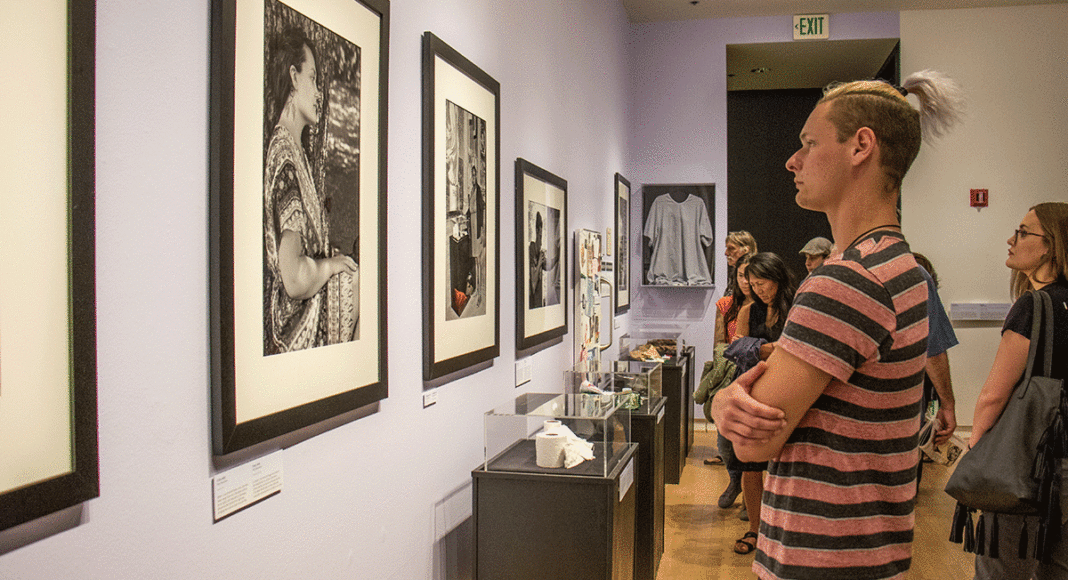When Patrick McGrath was 13 years old and living in a group home for foster youth, another kid charged at one of his friends, swinging a skateboard overhead.
McGrath, who was larger than others his age, tried to shield his friend, he says, and ended up taking serious blows to the head, neck, and shoulder, before managing to calm the angry boy and restrain him.
“If I ignored him, he was going to attack my friend using a skateboard like it was a baseball bat, and probably was going to kill him,” he says.
Seven years later, McGrath is an intern for the Museum of Art and History, helping to assemble Lost Childhoods, an exhibit on life inside the California foster care system. The ramifications of that skateboard attack and the group home’s handling of it impacted McGrath greatly, he says, and he worries the conditions that stem from it will leave him with an uncertain future when he graduates from the system at age 21, in a couple of months.
That feeling of being left in the lurch is common among current and former foster youth. Estimates vary, but some studies show that more than a quarter of foster youth experience homelessness within the first few years of leaving the system. According to the recently released Santa Cruz County 2017 Homeless Census and Survey, 27 percent of the homeless population had been through the foster care system at some point. Some try to get out before they are pushed out.
“It’s not uncommon for children to run away from the foster care system, and it isn’t hard to understand why,” says recent UCSC grad Jess Prudent at the MAH exhibit, beside a black-and-white photograph of a foster youth sleeping in a sleeping bag on a park bench. Though she never went through the system, she identifies with some of the exhibit’s troubling themes because she remembers growing up in an abusive home herself.
Cynthia Druley, executive director of the local chapter of Court Appointed Special Advocates (CASA), says that she often knows the foster youth who come through the nonprofit “on a high level”—sometimes in a court docket or piles of paperwork. But the MAH’s exhibit, which will be on display through the end of the year, immerses people in the world of foster care more deeply.
“There was this level of detail and personal information that was so moving for me,” Druley says. “I had two people with me that didn’t know much about children in foster care. We were all in tears. To know what it’s like to not have security. With seven day’s notice, they can tell you they don’t want you in their home, and then you move onto a different home.”
She says foster youth often struggle because they lack the connections that many young people have, which can plague them even after they graduate from the system.
“If the rent goes up,” she says, “they can’t call mom or dad as my son did, and say, ‘Can I come back home?’ Those people become homeless.”
As McGrath nears his 21st birthday, the search for work grows more daunting, as he feels he doesn’t have those networks many people his age do.
He had plans to be a mechanic, and he graduated from Santa Cruz High School with a certification through the Regional Occupation Program to become a general service and Valvoline lube technician, after moving in with his grandma at age 16. He moved away to Sacramento, enrolling at Universal Technical Institute, where he excelled. But once the curriculum got into transmission work, he had to leave because he could not lift the equipment due to issues stemming from his injuries as a teenager at the group home. Eventually, he moved in with his grandmother, Roberta.
Along the way, he’s had several surgeries, in both his right arm and his shoulder, after his old group home had initially tried to cover up the incident for years, brushing it off as scoliosis. Eventually, McGrath’s grandmother and his court advocate managed to track down the hospital records and start getting him care. Since then, he’s had two reconstructive surgeries on his arm and two more on his shoulder.
“I found out in high school there was a chance I could become permanently disabled for my whole life, which there still is,” he says. “I’m trying hard to fix my arm, but it’s a little harder than it seemed at first.”
Part of the problem, Roberta says, is that he hasn’t been able to get any physical therapy through the state’s insurance. “The system covered it up, and the system has kept him from having physical therapy that was needed for him to regain his strength,” says Roberta, who spent her retirement fighting for custody of her grandson.
Meanwhile, legislative reforms are ushering in changes, hopefully for the better. A 2015 law written by Assemblymember Mark Stone aims to phase out group homes, and created a thorough vetting process for resource families—formerly called foster families—that went into effect in January.
McGrath has been taking Cabrillo College business courses, and hopes to someday own a car shop. Still, he worries that if he doesn’t get approved for disability benefits or find work by the time he graduates, he’ll end up homeless. Roberta says because she lives in government housing, he should be able to seek assistance through other avenues.
“I have a core belief that God gives us no more than we can handle. There is some reason all of this is happening to him,” says Roberta. “I do say, ‘All of this will be behind you someday. You’ll understand.’ But right now, he’s feeling like he’s next to nothing.”













